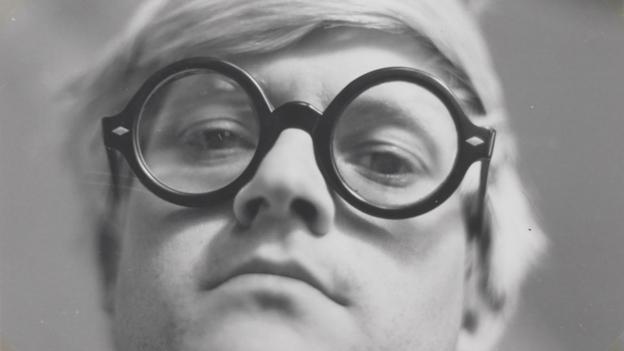David Hockney was continually rejuvenated by his transatlantic commuting. The painter, printmaker, draughtsman, photographer, and stage designer, was also a writer producing theories of seeing, and was fascinated by digital technology. Randall Wright's narration is set out in a series of short chapters in a montage-cum-collage of photographs, earlier films both amateur and professional, home video and recent interviews with the inhabitants of Hockney’s world today and in the past. We see a lot of septuagenarians and octogenarians, as well as film clips and photographs of the same people in their shining youth.
He was liberated just out of the Royal College when he got to New York with £300 in his pocket, having just managed to sell some of his work. An old friend tells us that it was in New York, while watching the television ad for Clairol – blondes have more fun – that Hockney first applied the self-administered dye to create the permanent blond mop that became his sartorial trademark. He had escaped Bradford too, yet we are reminded of his profound affection for his family and his respect and admiration for his parents. We see an old film of his father standing in a Bradford street next to Hockney, trying and failing to wrest a cigarette out of the mouth of his defiantly smoking son. Hockney who is famously still a determined smoker shows us a poster: DEATH awaits you even if you smoke.
Hockney himself tells us he was brought up by Hollywood in Bradford, as he saw every film going, and didn’t watch his first television until he was 18. And he loves Los Angeles, where he now is: the energy of America, irradiated by the energy of the Mediterranean, he informs us.
His best friend was the rotund, bearded curator and leader of the contemporary art world, the New Yorker Henry Geldzahler. There is remarkable footage of Henry Geldzahler simply lying down next to Hockney and cuddling him when the artist was saddened and depressed. Another friend shows us a napkin where Henry had written down Hockney’s characteristics as he saw them: stubborn, unintentionally rude, emotional. A Metropolitan Opera designer tells us Hockney is one of the few stage designers who had real reverence and respect for the music, and we have snatches of Ravel, Poulenc, and Wagner, while Hockney tells us he can no longer go to the opera he loves because of his profound deafness. Ken Tyler of the eponymous print studio shows us old film clips of Hockney at work: his art was rejuvenated by making the sequence of huge Paper Pools, fantasies on water, with Tyler’s help, and there is an absorbing sequence on just what the depiction of water has meant to him and his career.
The emphasis is mostly on the 1960s and 1970s, where the web of friendships was woven that informed his moves between Yorkshire, London, New York and Los Angeles. The artist tells us of his belief that painting can change the world; that friends are the thread that binds his life together; and one friend remarks that Hockney is still searching. Absent friends – mostly through AIDS – figure too, in a series of haunting, unlabelled portrait drawings.
Although all the interviewees are named as they are spliced into the visual and verbal commentary, there is a large cast of characters, almost exclusively male, and it is hard sometimes to keep track. The result is rather disjointed, held together by Hockney’s own charm, apparent candour, and extraordinary energy. At least the film whilst confusing is relatively free of gush, and while not revelatory in spite of the emphasis on unprecedented access to private archives, is enjoyable – as Hockney’s art is.
The last shots are curiously melancholy: Hockney today, slowly walking down some steep brick stairs in his California garden, down to the pool – and back up again, looking for we know not what. The underlying tristesse is emphasised by specially composed music by the clarinettist John Harle but we are also treated, obvious as it may be, to Nat King Cole’s irresistible "L.O.V.E" turning up several times to give us something upbeat.
Overleaf: watch the trailer for Hockney














Add comment